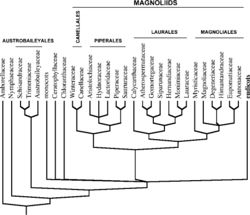Magnoliids: Difference between revisions
Created page with "=Definition= 250px|thumb|[2] Magnoliids, are a somewhat basal group of flowering plants containing somewhere around 10000 species. Early fossi..." |
No edit summary |
||
| Line 1: | Line 1: | ||
=Definition= | =Definition= | ||
[[File:Magnoliid Phylogeny.jpg|250px|thumb|[2]]] | [[File:Magnoliid Phylogeny.jpg|250px|thumb|[2]]] | ||
Magnoliids, are a somewhat basal group of flowering plants containing somewhere around | Magnoliids, are a somewhat basal group of flowering plants containing somewhere around 10,000 species. Early fossils of magnoliid species can be dated back to the early Cretaceous period. The members of this group vary greatly morphologically and geographically. Members can be traced to every continent (except Antarctica) in a multitude of ecological environments, mostly temperate to tropical, ranging from tall, fast growing woody trees like the tulip tree to the herbaceous viny wild ginger. [4] | ||
=Classification= | =Classification= | ||
| Line 13: | Line 13: | ||
== References == | |||
[1] Hu, Xiao-Min & Zeng, Qing-Wen & Fu, Lin. (2012). Magnolia hookeri var. Longirostrata (Magnoliaceae), a New Taxon from Yunnan, China. Annales Botanici Fennici. 49. 417-421. 10.5735/085.049.0618. | [1] Hu, Xiao-Min & Zeng, Qing-Wen & Fu, Lin. (2012). Magnolia hookeri var. Longirostrata (Magnoliaceae), a New Taxon from Yunnan, China. Annales Botanici Fennici. 49. 417-421. 10.5735/085.049.0618. | ||
Revision as of 13:52, 25 April 2019
Definition

Magnoliids, are a somewhat basal group of flowering plants containing somewhere around 10,000 species. Early fossils of magnoliid species can be dated back to the early Cretaceous period. The members of this group vary greatly morphologically and geographically. Members can be traced to every continent (except Antarctica) in a multitude of ecological environments, mostly temperate to tropical, ranging from tall, fast growing woody trees like the tulip tree to the herbaceous viny wild ginger. [4]
Classification
Magnoliids are a group of angiosperm organisms that include four subgroups, Canellales, Laurales, Magnoliales and Piperales. The differentiation between the larger group magnoliids and its subgroup magnoliales is sometimes confused as the result of multiple reclassifications of these groups over their course of study. [3]

Description
Magnoliids are very basic forms of angiosperms, and have characteristics that carry through to other members of angiosperms, but do have slight variations between themselves. Most magnoliid flowers have unfused carpels, surrounded by one, two or no spirals of trimerous petals. Leaves of magnoliids are generally pinnate with slight variation between species. Pollen of magnoliids are generally single pored, and have two cells present during fertilization. One cell produces the pollen tube, and the other cell, the sperm nuclei, fertilizes to form the embryo.

Most other angiosperm plants release pollen with two sperm nuclei, but most magnoliid members release sperm with only one, which splits into two during double fertilization. Seeds formed by magnoliid members are often released before the embryos are fully developed, but the large endosperm common with members of this group assist in its germination process by providing enough nutrients to properly develop. [4]
Agricultural Uses
Magnoliales, a subgroup of Magnoliids, have widespread economic and agricultural uses. Timber of members of this family, such as lancewood found in South America and the West Indes, has a yellow wood of fine texture with very fine grain suitable for carving and miscellaneous shape-dependant uses. The fine grains of these trees may be ground up into a powder and used for a yellow dye. Several genera of these species have very flexible, elastic qualities useful for wheels, masts of ships and some house beams. Custard apple, sweetsop, pawpaw and a few other species of trees are grown for their fruits. The Myristica Fragrans plant is the source of both nutmeg and mace. [6]
References
[1] Hu, Xiao-Min & Zeng, Qing-Wen & Fu, Lin. (2012). Magnolia hookeri var. Longirostrata (Magnoliaceae), a New Taxon from Yunnan, China. Annales Botanici Fennici. 49. 417-421. 10.5735/085.049.0618.
[2]Soltis, P. S. and Soltis, D. E. (2004), The origin and diversification of angiosperms . Am. J. Bot., 91: 1614-1626. doi:10.3732/ajb.91.10.1614
[3]The Angiosperm Phylogeny Group, M. W. Chase, M. J. M. Christenhusz, M. F. Fay, J. W. Byng, W. S. Judd, D. E. Soltis, D. J. Mabberley, A. N. Sennikov, P. S. Soltis, P. F. Stevens, An update of the Angiosperm Phylogeny Group classification for the orders and families of flowering plants: APG IV, Botanical Journal of the Linnean Society, Volume 181, Issue 1, May 2016, Pages 1–20, https://doi.org/10.1111/boj.12385
[4]Sampson, F. Bruce, and James Edward Canright. "Magnoliid Clade." Encyclopædia Britannica. September 22, 2017. Accessed April 10, 2019. https://www.britannica.com/plant/Magnoliid-clade
[5]Berry, Paul E., Peter Stevens, Arthur Cronquist, David L. Dilcher, Dennis William Stevenson, and Martin Huldrych Zimmermann. "Angiosperm." Encyclopædia Britannica. December 05, 2018. Accessed April 15, 2019. https://www.britannica.com/plant/angiosperm.
[6]Sampson, F. Bruce, Paul E. Berry, and James Edward Canright. "Magnoliales." Encyclopædia Britannica. December 10, 2017. Accessed April 21, 2019. https://www.britannica.com/plant/Magnoliales.